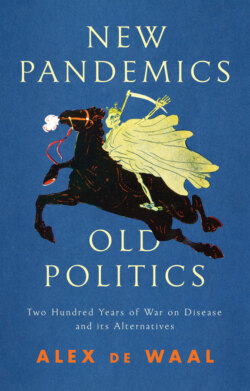Читать книгу New Pandemics, Old Politics - Alex de Waal - Страница 8
Following the Science
ОглавлениеExperts on pandemics like the storm metaphor. The influential health scientist Michael Osterholm has compared an influenza pandemic to a blizzard and coronavirus to a hurricane.2 In 2007, the United States Federal Government published a preparedness plan that adapted the five-level tropical storm classification scale for use in responding to epidemics (where a ‘category 5’ is the most destructive).3 It grades national-level disease outbreaks in terms of fatalities. According to its rankings, Covid-19 in 2020 would be category 2 (that is, an order of magnitude less severe than some of the diseases anticipated.) The scale may be a useful prop for getting politicians to take notice, but it reproduces an elementary mistake. A pandemic isn’t just a disease outbreak or epidemic multiplied to pan-continental size. Scale is important, for sure, but there’s a qualitative aspect as well. The World Health Organization (WHO) stirred controversy in 2009 when it quietly changed its definition of an influenza pandemic. The previous definition was ‘when a new influenza virus appears against which the human population has no immunity, resulting in several simultaneous epidemics worldwide with enormous numbers of deaths and illness’. The revised one cut out the words ‘enormous numbers of deaths and illness’.4 A pandemic that doesn’t cause massive human suffering might seem odd to the layperson, but the virologists’ particular concern is the newness of the pathogen and not how many people it sickens and kills. The novel coronavirus that causes Covid-19 is exactly such a candidate. Its closest relative is severe acute respiratory syndrome (SARS), which emerged in 2002, and it has some epidemiological similarities to influenza, but Covid-19 possesses characteristics all of its own.
For doctors, microbiologists, and epidemiologists, what matters in the storm isn’t so much the wind but the darkness: we can’t see our way. There’s a trope among crisis epidemiologists: if you’ve seen one pandemic, you’ve seen just one pandemic.5 The health metrics expert Chris Murray described constructing his model for Covid-19 as ‘forecasting the weather while trying to build the forecasting tools’.6 Perhaps we should adapt the storm metaphor to capture the fact that each pandemic isn’t just a hurricane, it’s a new kind of weather condition. Margaret Chan, Director General of the WHO in 2009, observed ‘the virus writes the rules’.7 Those rules govern how the disease is transmitted, which people are symptomatic and which are contagious and when, and what the microbe does to the human body and brain. It can take years to figure them out. In the case of the novel coronavirus, science has moved with unprecedented speed, but it is still lagging behind the epidemic curve. What we do during that lag is what’s most important.
We like to think that biomedical scientists can provide authoritative certainty. As a pandemic hits, that isn’t so. They are confident that their research methods will provide answers, but they don’t have them yet. A new pathogen is an off-model event and models don’t (by definition) predict them. In these events, it’s the narrative that counts.8 Scientists also have difficulty in explaining what their uncertainties mean to the public. In turn, every doubt or debate feeds the appetite of denialists, conspiracists, and pseudo-scientists, such as anti-vaxxers. In America, changes in advice to the public from the Centers for Disease Control and Prevention (CDC) in the early days of Covid-19 – initially advising against stopping incoming travellers from Europe and China9 – have been repeatedly brought up by far-right pundits purportedly to show that public health authorities can’t be trusted. Public health spokespeople and science journalists find that debating denialists registers somewhere between irritation and enraged despair. The difficulty is that the history of medicine includes enough moral outrages, good-faith errors, and unanticipated calamities to justify critical questioning. But leveraging these concerns to assail the whole edifice is to misunderstand the nature of scientific authority. To the religious dogmatist, authority is flat: all statements of scripture possess the same sacred quality, and to doubt one is to doubt all. To the scientific mind, theories are open to revision, technologies are not infallible, but facts are real.
Science is itself a journey. Every time the climbers reach a summit, they see a new vista of peaks and valleys to explore. The history of science shows that understanding a pandemic pathogen isn’t merely an increment to existing medical knowledge but can also be a paradigm-shifting breakthrough. For each of the main pathogens examined in this book – cholera, influenza, and HIV, plus yellow fever and Ebola, which are covered more briefly – the search for prevention and cure has taken scientists into new terrain they could not have anticipated. Of all the sciences, medicine is the one most focused on the human being as such, and it is notable that it has been biologists who have blurred the boundaries of the human self, imputed agency to microbes, and in other ways challenged the distinction between the natural world and the human, so foundational to our modernist worldviews. Bruno Latour has made the same observation with regard to those hardest of hard scientists, geologists, who coined the word ‘Anthropocene’ to refer to our current era in which human activities are determining the global ecosystem. He writes: ‘No postmodern philosopher, no anthropologist, no liberal theologian, no political thinker would have dared measure the influence of humans on the same scale as rivers, volcanos, erosion and biochemistry.’10 In medicine as in geology, such critique doesn’t come from post-modernist literary theorists, but from the Sherpas of scientific exploration themselves. We will see that this is the case for Covid-19 too.
